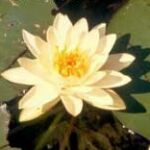| Common Name: |
Fragrant Water Lily |
| Other Names: |
White Pond Lily |
| Botanical Name: |
Nymphaea Odorata |
| Genus: |
Nymphaea |
| Family: |
Nymphaeaceae |
| Native Location: |
NE USA |
| Cultivation: |
Rich soil in still water, to 45cm (18in) deep (N. odorata); right soil in still water at least 30cm (12in) deep (N. lotus). Both species need full sun. Dormant tubers of N. lotus may be stored in moist sand. Aphids may attack plants. Water lily beetles and caterpillars may eat leaves. Deep water and over-rich soil inhibit flowering. |
| Propagation: |
By seed sown when ripe at 10-13°C (50-55°F) for hardy species, and 23-27°C (73-81°F) for tender species; by offsets or division of rhizomes in spring or early summer. Sow seeds on surface of wet soil mix, covering with 2.5cm (1in) of water. |
| Harvest: |
Flowers are cut when open and used fresh for infusions. Rootstocks are lifted when dormant and used fresh or dried for decoctions (N. lotus). Fruits and seeds are harvested when ripe and used fresh. Rhizomes are lifted in autumn, after the leaves have died down, and are dried for decoctions, liquid extracts, and powders (N. odorata). |
| Width: |
1.2-1.8m (4-6ft) |
| Variations: |
Rosea
Has deep pink strongly scented flowers to 10cm (4in)
Native to E. USA |
| Hardiness: |
Z3-11 |
| Parts Used: |
Rhizomes |
| Properties: |
A soothing, astringent, antiseptic herb; releives pain and has alterative effects. |
| Medicinal Uses: |
Internally for tuberculosis, chronic bronchial complaints, diarrhea, dysentery, gastrointestinal inflammation, gonorrhea, vaginal discharge, cystitis, prostatitis, uterine infections, and uterine cancer. Externally for boils, abscesses, conjunctivitis, sore throat, and vaginitis. Combined with Prunus serotina (See, Wild Black Cherry) for bronchial complaints, and with Linum usitatissimum (See, Flax) and Ulmus rubra (See, Slippery Elm) for boils. |
| Culinary Uses: |
Leaves are added to soups and stews. Flower buds are pickled or cooked as a vegetable. |
| Bibliography: |
The Encylopedia of Herbs by Deni Bown Copyright © 1995, 2001 Dorling Kindersley Limited pp 289-290 |
